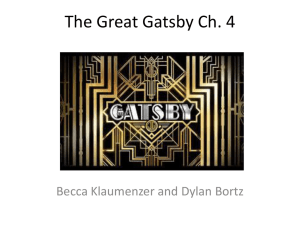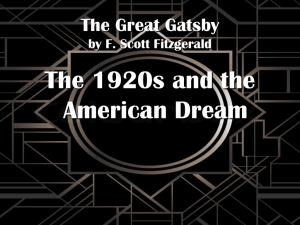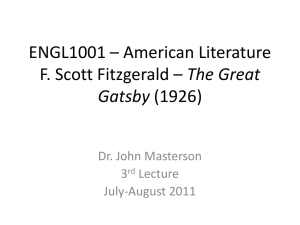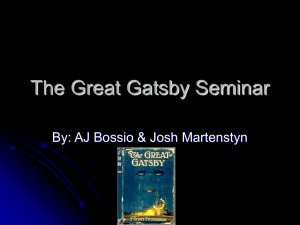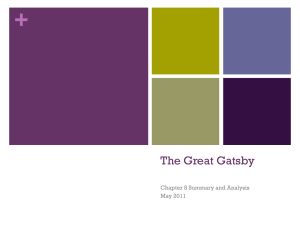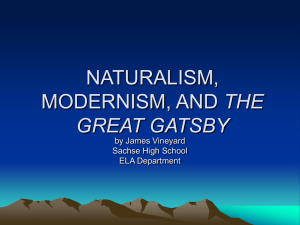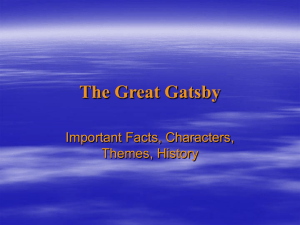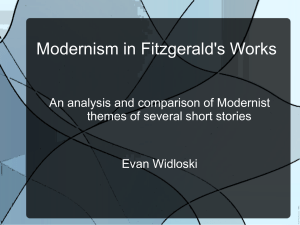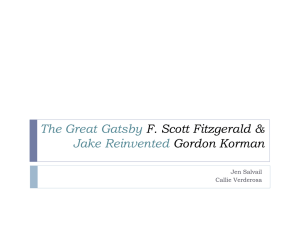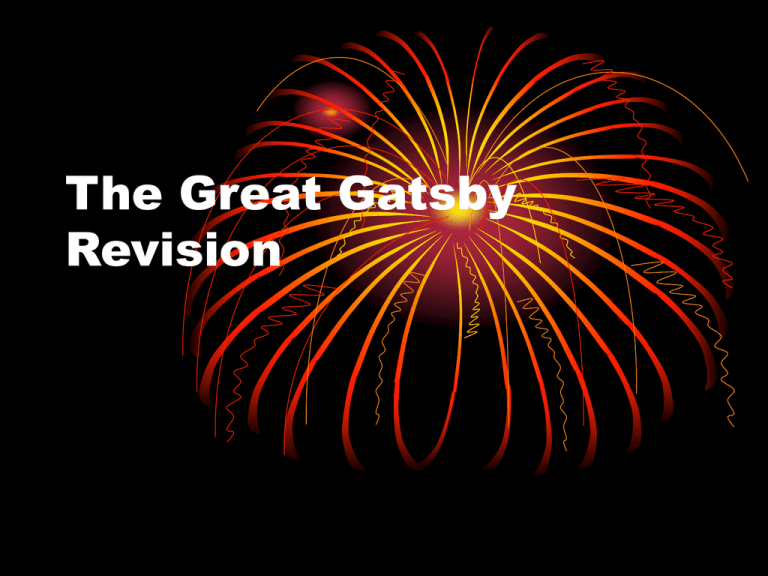
The Great Gatsby
Revision
Nick Carraway
• Nick is a narrator whose values you should have no
trouble identifying or at least sympathizing with.
He's not mad or blind to what's going on around
him. He's a pretty solid young man who has
graduated from Yale University, served his country
in the First World War, and decided to go into the
bond business. He comes from a solid Midwestern
family, from whom he has learned some pretty
basic values. He is honest, but not Puritanical or
narrow minded. He is tolerant, understanding, and
not hasty to judge people. He is the sort of person
you might talk to if you wanted a sympathetic ear.
But his toleration has limits. He doesn't approve of
everything.
• He both admires Gatsby and disapproves of him. He
admires Gatsby both because of his dream and because
of his basic innocence; and he disapproves of Gatsby for
his vulgar materialism and his corrupt business
practices. (Nick does not want to become involved with
Meyer Wolfsheim, Gatsby's underworld "connection.")
• As you're deciding about Nick's powers of judgment-particularly in the opening and closing pages where he
talks about himself--keep in mind that Nick is a
Midwesterner and his values are coloured by the values
of the world in which he grew up.
Gatsby
• The title of this novel is The Great Gatsby. If you
like paradoxes, start with this one: he is neither
great nor Gatsby (his real name was Gatz). He is a
crook, a bootlegger who has involved himself with
Meyer Wolfsheim, the man who fixed the 1919
World Series. He has committed crimes in order to
buy the house he feels he needs to win the woman
he loves, who happens to be another man's wife.
Thus a central question for us as readers is, why
should we love such a man? Or, to put it in other
word, what makes Gatsby great? Why, despite all
these things, does Fitzgerald invite us to cry out
with Nick, "'They're a rotten crowd '... 'You're worth
the whole damn bunch put together.'"?
• Review what is admirable about Gatsby and what is
to dislike about him.
Daisy Fey
• She was born Daisy Fay in Louisville, Kentucky, and her
color is white. When Jordan Baker, in Chapter IV, tells
Nick about the first meeting between Gatsby and Daisy in
October 1917, she says of Daisy, "She dressed in white,
and had a little white roadster, and all day long t he
telephone rang in her house and excited young officers
from Camp Taylor demanded the privilege of
monopolizing her that night."
• Throughout The Great Gatsby Daisy is described almost
in fairytale language. The name Fay means "fairy" or
"sprite." "Daisy," of course, suggests the flower, fresh
and bright as spring, yet fragile and without the strength
to resist the heat and dryness of summer.
• Daisy is the princess in the tower, the golden girl that
every man dreams of possessing. She is beautiful and
rich and innocent and pure (at least on the surface) in her
whiteness. But that whiteness, as you will notice, is
mixed with the yellow of gold and the inevitable
corruption that money brings. Though Daisy seems pure
and white, she is a mixture of things, just like the flower
for which she was named
• Her voice is full of money," he said suddenly.
• That was it. I'd never understood it before. It was full of
money--that was the inexhaustible charm that rose and
fell in it, the jingle of it, the cymbals' song of it.... High in
a white palace the king's daughter, the golden girl....
• Like money, Daisy promises more than she gives. Her
voice seems to offer everything, but she's born to
disappoint. She is the sort of person who is better to
dream about than to actually possess
• Be careful not to identify Daisy with
the green light at the end of her
dock. The green light is the promise,
the dream. Daisy herself is much
less than that. Even Gatsby realize
that having Daisy in the flesh is
much, much less than what he
imagined it would be when he fell in
love with the idea of her.
Tom Buchanan
• Because he is both very strong and very rich, Tom is used
to having his own way. Nick describes him as having "a
rather hard mouth" and "two shining arrogant eyes."
When we first meet him in Chapter I, he reveals his crude
belief in his own superiority by telling Nick that he has
just read a book called The Rise of the Colored Empires.
The book warns that if white people are not careful, the
black races will rise up and overwhelm them. Tom clearly
believes it.
• Tom is having an affair with Myrtle Wilson, the wife of
George Wilson, who runs a garage in the valley of ashes.
Myrtle seems to have a dark sexual vitality that attracts
Tom, and he keeps an apartment for her in New York,
where he takes Nick in Chapter II. Here he again shows
how little he thinks of anyone beside himself when he
casually breaks Myrtle's nose with the back of his hand,
because she is shouting "Daisy! Daisy!" in a vulgar
fashion.
• It is Tom who pushes the affair between
Gatsby and Daisy out into the open by
asking Gatsby point blank, "'What kind of a
row are you trying to cause in my house
anyway?" It is Tom who verbally outduels
Gatsby to win his wife back and deflate his
rival's dream. And it is Tom who, after the
death of Myrtle Wilson, tells George Wilson
that Gatsby was the killer and then hustles
Daisy out of the area until the affair blows
over.
Jordan Baker
• Jordan Baker's most striking quality is her
dishonesty. She is tough and aggressive--a
tournament golfer who is so hardened by
competition that she is willing to do anything to
win. At the end of Chapter IV, when Nick is telling
us about Jordan, he remembers a story about her
first major tournament. Apparently she moved her
ba l l to improve her lie (!), but when the matter was
being investigated, the caddy and the only other
witness to the incident retracted their stories and
nothing was proved against her. The incident
should stay with you throughout the novel,
reminding you (a s it reminds Nick) that Jordan is
the smart new woman, the opportunist who will do
whatever she must to be successful in her world.
• In many ways Jordan Baker symbolizes a new type
of woman that was emerging in the Twenties. She
is hard and self-sufficient, and she adopts whatever
morals suit her situation. She has cut herself off
from the older generation. She wears the kind of
clothes that suit her; she smokes, she drinks, and
has sex because she enjoys them. You may wish to
explore Jordan as the new woma n of the Twenties
by looking at the manners and character traits she
reveals. Note such things as her name (a masculine
name), her body (hard, athletic, boyish, smallbreasted), her style (blunt, cynical, bored), and her
social background (she is cut off from past
generations by having almost no family).
• Jordan helps us understand the setting of the novel
Setting
The setting in The Great Gatsby is very important because in
Fitzgerald's world setting reveals character.
Fitzgerald divides the world of the novel into four major settings: 1.
East Egg; 2. West Egg; 3. the Valley of Ashes; and 4. New York
City.
Each of these settings both reflects and determines the values of
the people who live or work there. East Egg, where Tom and
Daisy live, is the home of the Ivy League set who have had
wealth for a long time and are comfortable with it. Since they
are s ecure with their money, they have no need to show it off.
Nick lives in new-rich West Egg because he is too poor to afford
a home in East Egg; Gatsby lives there because his money is
"new" and he lacks the social credentials to be accepted in East
Egg. Hi s house, like the rest of his possessions (his pink suit,
for example), is tasteless and vulgar and would be completely
out of place in the more refined and understated world of East
Egg. No wonder that Gatsby is ruined in the end by the East, and
that Nic k decides to leave.
• The Valley of Ashes in contrast to both
Eggs is where the poor people live--those
who are the victims of the rich.
• It is characterized literally by dust, for it is
here that the city's ashes are dumped (in
what is now Flushing, Queens), and the
inhabitants are, as it were, symbolically
dumped on by the rest of the world. The
valley of ashes, with its brooding eyes of
Dr. T. J. Eckleburg, also stands as a symbol
of the spiritual dryness, the emptiness of
the world of the novel.
• New York City is a symbol of what
America has become in the 1920s: a
place where anything goes, where
money is made and bootleggers
flourish, and where the World Series
can be fixed by a man like Meyer
Wolfsheim. New York is a place of
parties and affairs, and biz arre and
colorful characters who appear from
time to time in West Egg at Gatsby's
parties.
Themes
• There are several Major themes
in the novel and many minor
ones.
The American Dream and the
Corruption of the American Dream
• The American Dream--as it arose in the Colonial period
and developed in the nineteenth century--was based on
the assumption that each person, no matter what his
origins, could succeed in life on the sole basis of his or
her own skill and effort. The dream was embodied in the
ideal of the self-made man, just as it was embodied in
Fitzgerald's own family by his grandfather, P. F. McQuillan.
• The Great Gatsby is a novel about what happened to the
American dream in the 1920s, a period when the old
values that gave substance to the dream had been
corrupted by the vulgar pursuit of wealth. The characters
are Midwesterners who have come East in pursuit of this
new dream of money, fame, success, glamour, and
excitement. Tom and Daisy must have a huge house, a
stable of polo ponies, and friends in Europe. Gatsby must
have his enormous mansion before he can feel confident
enough to try to win Daisy.
• What Fitzgerald seems to be criticizing in The Great
Gatsby is not the American Dream itself but the
corruption of the American Dream. What was once a
belief in self-reliance and hard work has become what
Nick Carraway calls "...the service of a vast, vulgar, and
meretricious beauty." The energy that might have gone
into the pursuit of noble goals has been channeled into
the pursuit of power and pleasure , and a very showy, but
fundamentally empty form of success.
•
How is this developed? Fitzgerald's critique of the dream
of success is developed primarily through the five central
characters and through certain dominant images and
symbols. The characters might be divided into three
groups: 1. Nick, the observer and commentator, who sees
what has gone wrong; 2. Gatsby, who lives the dream
purely; and 3. Tom, Daisy, and Jordan, the "foul dust" who
are the prime examples of the corruption of the dream.
•
•
•
•
•
•
•
•
•
•
The primary images and symbols that Fitzgerald employs in developing
the theme are:
1. the green light;
2. the eyes of Dr. T. J. Eckleburg;
3. the image of the East and Midwest;
4. Owl Eyes;
5 There is he billboard with T.J. Eckelburg. The billboard is right over the
valley of ashes. The billboard consists of really big eyes and even bigger
spectacles. There is a plethora of meanings behind this billboard:
he watches over everything that goes on around in the valley.
, his glasses have yellow rims which symbolize corruptness in two
different ways. (1) That all he sees is corruptness, and,(2) he sees
through the eyes of someone who is corrupt.
The empty face represents the hollowness of people and their
materialistic values. The empty face also represents an empty,
unresponding, and dead God.
6. Dan Cody's yacht; and
7. religious terms such as grail and incarnation.
Decay
• Decay is a word that constantly comes up in The Great
Gatsby, which is appropriate in a novel which centres
around the death of the American Dream.
• Decay is most evident in the so-called "valley of ashes."
With great virtuosity, Fitzgerald describes a barren
wasteland which probably has little to do with the New
York landscape and instead serves to comment on the
downfall of American society. It seems that the American
dream has been perverted, reversed. Gatsby lives in West
Egg and Daisy in East Egg; therefore, Gatsby looks East
with yearning, rather than West, the traditional direction
of American frontier ambitions. Fitzgerald portrays the
chauvinistic and racist Tom in a very negative light,
clearly scoffing at his apocalyptic vision of the races
intermarrying. Fitzgerald's implication seems to be that
society has already decayed enough and requires no new
twist.
Class
• Class is an unusual theme for an American novel. It
is more common to find references to it in
European, especially British novels.
• The societies of East and West Egg are deeply
divided by the difference between the noveau riche
and the older moneyed families.
• Gatsby is aware of the existence of a class
structure in America – he is at arm’s length.
• Gatsby tries desperately to fake status, even
buying British shirts and claiming to have attended
Oxford in an attempt to justify his position in
society. Ultimately, however, it is a class gulf that
separates Gatsby and Daisy, and cements the latter
in her relationship to her husband, who is from the
same class as she is.
Wealth
• In The Great Gatsby, wealth can be distinguished from
class; it is possible to achieve great wealth without being
accepted into the elite class, as evidenced by Jay
Gatsby’s experience.
•
Poverty, on the other hand, restricts decision and action.
George Wilson, for example, is unable to "go West" with
his wife because he hasn’t enough money. It is money
that allows Tom and Daisy to go here and there, leaving
other people to clean up their messes. The life of ease
and luxury that Tom and others enjoy is contrasted
sharply with the stranglehold of poverty containing
Myrtle and George Wilson or the life from which Jay
Gatsby emerges. Wealth is what separates Gatsby from
his love, as he notes of Daisy that "her voice is full of
money."
Betrayal
• The theme of betrayal is prevalent throughout the
novel, as we see several examples through analysis
of the various relationships.
• Tom betrays Daisy and their vows through his serial
infidelities. Daisy betrays Gatsby by returning to
her husband and ultimately being responsible for
his death. Tom betrays Gatsby by identifying him
as being the driver of the car the killed Myrtle.
“They were careless people, Tom and Daisy -- they
smashed up things and creatures and then
retreated back into their money or their vast
carelessness or whatever it was that kept them
together, and let other people clean up the mess
they had made"
Other Possible Themes
• Love
• Gender Roles
• Violence
(typified by Tom)
• The Past
• Isolation
• Mortality
• Lies and deceit
• Compassion and
forgiveness
• Dissatisfaction
• Any else?
Symbolism
Colour Symbolisms:
Grey is the colour for dreariness.
White is the colour that has the deeper meaning of false purity
or goodness. Daisy and Jordan are always seen in white. Also,
Gatsby, when he wanted to meet Daisy again for the first time
in 5 years, he wore a white suit as if to show that he was good
and pure.
Green represents many things in this novel.
Red represents blood and death.
Yellow is in many facets of the book. Yellow in general means
corruptness and things that go bad. –Yellow leaves represent
decay and corruptness. –The yellow of Gatsby’s car represents
corrupt dishonesty and deception.
Gold represents wealth, but, more so, the show of wealth. Gatsby
tried to win Daisy back by his parties and the show of wealth.
Symbolism cont.
Symbolism of people
Myrtle, Tom’s mistress, epitomizes the idea of a shrub that supports life,
vitality. Because she is full of life, and makes spontaneous descisions.
Daisy embodies a fragile flower, because she is a fragile person who can’t
make up her own mind.
Tom represents power, but mostly the abuse of the power that he has
been given.
Nick is someone who stands to the side. He has his own opinion, but he
doesn’t always express it. However he was one of the main people who
connected Gatsby to Daisy, which turned out to be a really bad thing. He
was like the un-innocent bystander.
Gatsby represents the result of a dream deferred. He overestimated what
it would be like with Daisy, so much that she could never in all her life live
up to his expectations. The more that the hope did not come alive, the
more he dreamed, and that made it all the worse for him and Daisy.
Other symbolism
•
The season of summer is hot, and it represents the heat and boiling point
of the story and or conflict.
•
Cars are a status symbol and can also represent carelessness and/or
recklessness.
•
Spring represents a new beginning, a clean slate to mess up all over
again.
•
Another big symbol that is exemplified throughout the book is eggs. The
East and West eggs are where they live, and there is always drama going
on. An egg is white on the outside, and yellow on the inside. So on both
sides of the spectrum there is deception everywhere. An egg symbolizes
a false show of purity on the outside, but rotten and corrupt on the inside.
•
Also the east egg represents old money that has been passed down from
generation to generation. The west egg represents new money that the
people who live inside there have earned.

